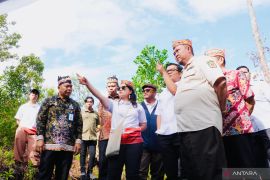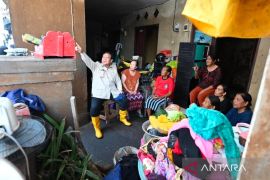Labor intensive assistance such as the construction reservoirs is also given to help improve the welfare of the people.Jakarta (ANTARA News) - The Indonesian government is planning to take labor intensive measures to develop retention basins and extend seed assistance as part of short term efforts to deal with increasing poverty rate among farmers.
These measures will be taken through the Ministry of Agriculture. Therefore, the minister will obligate regional governments and the farmers to plant assistance seeds on new land in an effort to increase production.
"We appeal to farmers to plant all seeds provided by the government such as soybean, maize and rice seeds on new fields," Minister Sulaiman said in Padang, West Sumatra, on Thursday. He made the remarks when opening the Archipelago Food Exposition 2015 at Tarandam Square, West Sumatra.
He said there was a region which received maize seed assistance worth Rp300 billion but it could not plant it on new farmlands so that the agriculture ministry asked that the assistance should be returned to the government.
"Many other regions can plant it on new land. So, if the district head is unable to do it, the assistance should be returned," he said.
He said that the policy is taken to launch intensive agricultural programs as one of the efforts to boost production.
"Usually, production of maize, soybean and rice never increase simultaneously. If one of them is rising, the production of others decline," he said.
Labor intensive assistance such as the construction reservoirs is also given to help improve the welfare of the people.
In East Nusa Tenggara (NTT), which is third poorest among the countrys 34 provinces, the government builds a number of reservoirs and retention basins.
NTT is lucky as a number of reservoirs will be built to help hold water in the region during the rainy season and supply it to the people during the dry spell.
One of these reservoirs is the Raknamo Reservoir, some 35 kilometers east of Kupang city. It is to supply standard water to urban areas and to irrigate around 841 hectares of farmlands in the district of Kupang.
Furthermore, the regional government of Sabu Raijua district in NTT will also build 74 retention reservoirs to cope with the impacts of the drought and to meet household and agricultural requirements.
The assistance is expected to increase production and improve the welfare of farmers whose poor rate is reported to have increased.
Agriculture Minister Amran Sulaiman admitted that the number of poor people in the agricultural sector has increased, as reported by the Central Bureau of Statistics (BPS), reaching 0.26 percent of the population over the past six months (September 2014 - March 2015).
While the BPS reported that the food and agricultural sector was the biggest contributor to the increase in the poverty rate, accounting for 60 percent, the minister denied the figure was that high.
"No, it is not 60 percent but only 23 percent," he said after delivering an address at a National dialogue on food resilience and agrarian reforms at the Ministry of Agriculture.
The minister acknowledged that poverty did exist among farmers although the government has extended assistance to them. An amount of Rp15.8 trillion has been allocated from the state budget to farmers in 2015.
"The benefit of this assistance will be visible to the farmers only next year, " Minister Sulaiman said.
He said several factors were responsible for the increase in the poverty rate among farmers, including the 14 percent increase in rice production cost last year, coupled with the facts that there were no rice imports and fuel subsidy was scrapped.
Referring to the rice production cost, borne by farmers, rising by 14 percent, the minister said it was still within limits. "The increase could have been considered a destabilizing factor if it had been, say, 30 percent," he said.
Meanwhile, the BPS said the number of poor people in Indonesia in March 2015 stood at 28.59 million, or 11.22 percent of the population.
The figure shows an additional 860 thousand people falling in this category, compared with 27.73 million poor people in September 2014, roughly 10.96 percent of the population.
"In March 2015, the number of poor people in Indonesia or people with a per capita spending per month below the poverty line, had reached 28.59 million, or 11.22 percent of the countrys total population," BPS Chief Suryamin told a press conference on Tuesday.
Suryamin explained that the number of poor people in urban areas in March 2015 was 10.65 million, or 8.29 percent of the population. In September 2014, 10.36 million people were considered poor, accounting for 8.16 percent of the population.
The number of poor people in rural areas also increased from 17.37 million (13.76 percent) in September 2014 to 17.94 million (14.21 percent) in March 2015
The BPS chief, Suryamin, emphasized that unless special efforts were undertaken, it would be difficult to reduce the poverty rate. It is similar to the situation in other ASEAN countries where reducing the poverty rate will become increasingly difficult when it reaches 11 percent.
He said the poverty rate in the country has now reached 11.22 percent, which is high.
However, the government is confident of reducing the poverty rate in the country despite the pessimism expressed by the National Statistics Agency.
"Regardless of how difficult it may be, we will certainly be able to reduce it. If productivity is increased and prices are decreased, it will certainly happen. Just because something is difficult, does not mean that it cannot be achieved," Vice President Jusuf Kalla stated at a coordination meeting on Wednesday.
Suryamin pointed out that most of the poor, totaling 17.94 million, live in villages, while the number of poor living in cities reaches 10.65 million.
In view of the situation, he has urged the government to continue to boost the economy in villages.
He affirmed that poverty in villages could be reduced by increasing the income of the people, including farmers.
"The economy in villages must be improved," he added.
According to Jusuf Kalla, if food prices are causing an increase in poverty rate, then the problem can be handled by boosting food production.
"Indeed, if the price of rice is high and the other food prices also increase, it will certainly increase the poverty figures wherein the cost of living will be high, and the needs of the people will not be met. In view of this, one of the solutions is to stabilize the food prices," he explained.
Therefore, Agriculture ministe, Sulaiman is preparing labor intensive assistance such as the construction of retention basins to help irrigate farmers' rice fields and the provision of seeds for farmers.
The minister said the short efforts made to reduce the poverty rate among the farmers would be effective in improving their welfare. The famers can directly get the benefit.(*)
Reporter: Andi Abdussalam
Editor: Heru Purwanto
Copyright © ANTARA 2015











